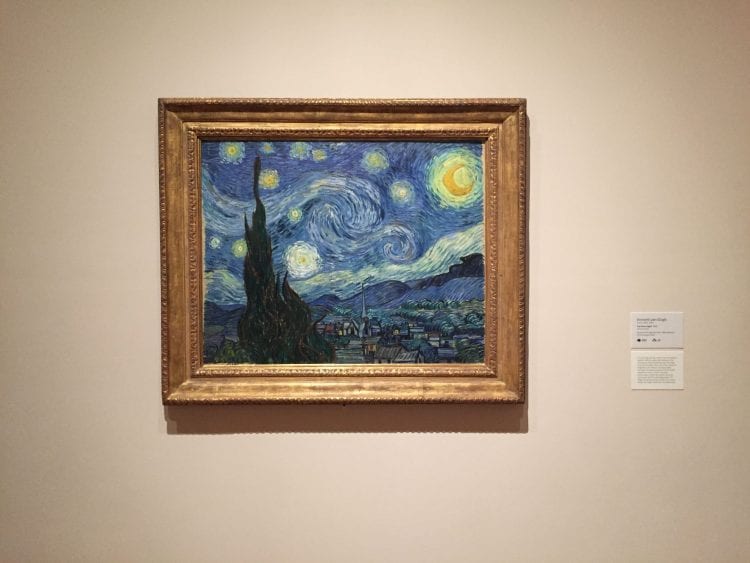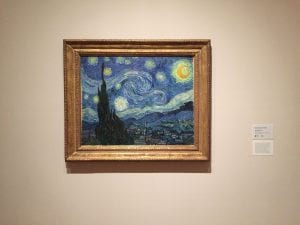Vincent Van Gogh
Starry Night
Oil on canvas
Saint Rémy, June 1889
Rather than a painting of specific scenery, Starry Night is more of an expression of Van Gogh’s emotion and imagination. With bold strokes as well as doleful and gloomy blue color scheme, Starry Night projects a very lively yet sad and lonely picture that perhaps describe Van Gogh’s mood at that period.
When first looking at this piece of artwork, the strong movement of the heavy strokes is completely innegligible. The first thing that caught my attention wasn’t the illusive tree, nor the shining starts, but the seemingly moving sky. Although the painting is of nighttime, I could feel endless energy and vitality in the lines; therefore I’d say the subject of this work is the sky.
The composition of Starry Night is relatively harmonic and calm compared to its lines. From the furthest these is the unbounded night sky and a conspicuous huge swirl in the center of the sky and the picture, following by mountains over mountains, and then a little village. Finally there is an enormous tree that takes almost one-fourth of the scene. The proposition is reasonable as well. Neglecting the lines, the anatomy itself is rational while full of layer, forming an obvious space. Nevertheless if you look at the way Van Gogh describe the tree on the left of the picture, its form and structure are completely raged. The tall tree seems like a furious flame, angrily burning, while the other buildings in the village are static and quiet. The sky, similar to the main building, is full of motion.
The line in Starry Night is the most focus-worthy part of this painting. As the lines of the mountains and village are steady and serene, the lines in the sky and tree are so energetic that it’s almost like they want to come out of the picture and blend into our world, or the reverse, sucking it’s viewers into its world, forming a strong contrast with the village. The short strokes are thick, bold and fairly clear as they form curved, swirling and flowing lines. Moreover the strokes around the moon and stars are to emphasize their brightness. Nevertheless, I’d say the texture of this painting is smooth and controlled. Despite the heavy strokes, the whole artwork looks firm and secured.
Finally, the use of color in this piece is absolutely splendid. The main color scheme here is blue with embellishment of green and grey; needless to mention the orange, bright yellow and white used around the moon and stars illuminate the entire painting, while the tree is colored in dark green with strokes of brown. The painting doesn’t consist heavy shadow or highlight except for the furthest mountain and bright starts. The light and dark in here is just Van Gogh’s mixing of colors.
The overall mood that this picture gave me is a subtly depressed, sad, yet wild deep in the heart. This can be due to Van Gogh’s mental instability and illness at the time he created this work, considering that he was in a psychiatric hospital and suffered from hallucination. I feel especially alone when I was looking at Starry Night because I could feel Van Gogh’s loneliness and struggles when he painted this artwork. This work was based on his memory and imagination, and I believe he added a lot of emotion to this painting, which eventually is so strong that became the focus and key of this work.
As one of the greatest postimpressionists, Van Gogh was definitely implementing how art isn’t to accurately imitate form, but to create one. From Starry Night it is clear that the artist is describing the world with his imagination and in his own point of view. As this work reflects Van Gogh’s intense emotion, it successfully execute the spirit of not only postimpressionism but also impressionism.

